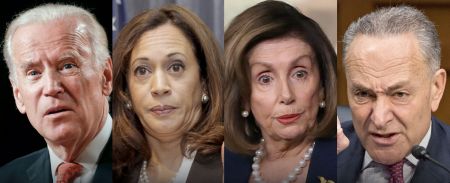Is the Working Class Vote becoming concentrated in states more Electorally Significant to a Presidential Election outcome?
Last week's Super Tuesday results ensured the renominations of both former President Donald Trump and President Joe Biden – barring some unanticipated adverse health events. So, who's going to win in November?
Polls give us clues. Trump continues to have the small but persistent lead in public polls he has maintained since November 2023 – in contrast to the 2016 and 2020 cycles in which he often trailed in national and targeted State Polls.
 But polls are only one indicator.
But polls are only one indicator.Actual votes are another.
And we've had one contest this year that provides important clues to the November vote: the California Primary.
Primary voters in California – like those in Alabama, Arkansas, Mississippi, North Carolina and Texas – have voted not just for president, but also for members of Congress and (in North Carolina as well) Governor and Statewide Officials. Those contests may draw turnout from voters with little motivation to participate in seemingly already decided presidential primaries.
And California, unlike those states but like Louisiana and Washington, has, except at the presidential level, all-party primaries, in which the top two candidates, regardless of party, advance to the general election.
The results of all-party primaries in many (but not all) cases can turn out to be good forecasts of the General Election.
For example, Washington state's 1994 results presaged the defeat of then-House Speaker Tom Foley – and the first Republican majority in the U.S. House in 40 years.
- READ MORE: Patrick Ruffini – "Why Blacks & Hispanics Are Turning to Trump"
- The "working class is concentrated in states that are more electorally significant to the outcome of the election."
The big news from California is that with 85% of the votes counted so far (high-tech California counts slowly), Democratic support is sagging a bit:
- With no viable opposition to either Biden or Trump,
- Democrats cast 59% of presidential votes, and
- Republicans cast 39%.
- That's down from the state's 63%-34% margin for Biden over Trump in 2020.
 It's nearly the same as Gov. Gavin Newsom's 59%-41% reelection in 2022, but weaker than his 62%-38% victory in 2018.
It's nearly the same as Gov. Gavin Newsom's 59%-41% reelection in 2022, but weaker than his 62%-38% victory in 2018.Those numbers don't mean difficulty for Biden in carrying California's 52 electoral votes or for Rep. Adam Schiff (D-Calif.), Congress's chief propagator of the Russia collusion hoax, in replacing Feinstein in the Senate – but it does suggest gains for Republicans in Congressional and State Legislative Districts, and it does lend credence to polling data (reviewed last month in this space,) showing Trump and Republican gains among Hispanic and Asian voters.
This year, Republicans won majorities in 13 districts to Democrats' 39, a vast improvement on the 46-7 Democratic margin in 2018 – when in reaction against Trump – Rep. Nancy Pelosi (D-Calif.) won back the House majority and the speaker's chair.
This year, Republicans won majorities in 13 districts to Democrats' 39, a vast improvement on the 46-7 Democratic margin in 2018 – when in reaction against Trump – Rep. Nancy Pelosi (D-Calif.) won back the House majority and the speaker's chair.
- Republican incumbents in three heavily Hispanic and Asian seats – who were elected with 51% in 2022 – got between 55% and 56% of primary votes this year.
- And Republicans won between 43% and 49% of Primary Votes in nine other districts, seven of them heavily Hispanic.
- Most of those seats aren't seriously contested this year, but most may be in years to come.
As Republican pollster Patrick Ruffini argues in his book "Party of the People," non-college-educated Hispanic people, Asian people, and Black people with conservative views are voting increasingly Republican, like non-college-educated white people.
California has seen something like this before.
Over the last three generations, the state has been populated by two brief but enormous surges of migration of (to oversimplify) Midwesterners from 1946 to 1973, and Mexicans from 1982 to 2007. The Midwesterners provided majorities first for Pat Brown liberals and, after riots in Berkeley and Watts, for Ronald Reagan conservatives.
 Midwestern migrants enabled Republicans to hold the governorship in six of eight elections from 1966 to 1994.
Midwestern migrants enabled Republicans to hold the governorship in six of eight elections from 1966 to 1994.Mexican voters entered the voting ranks more slowly. But in this century, they, together with liberal white college graduates in the San Francisco Bay Area and Westside of Los Angeles, have made once-marginal California solidly Democratic.
Just as settled-in Midwesterners soured on liberals' 1960s policies, so settled-in Mexicans seem to be souring on this generation's liberal excesses.
Gentry liberals' high turnout will probably keep California Democratic, but Republican trending in lower-turnout Mexican areas will reduce their ranks in Congress well below Pelosi highs.
Meanwhile, California has been losing population – down 538,000 between 2020 and 2023 – even as it lost one U.S. House seat in the reapportionment following the 2020 census.
Migration from Mexico halted during the 2007-2008 housing crunch, and today's illegal immigrants are surging toward Texas, not California.
California bitterly clings to much of the high-tech and entertainment industries, but it seems to be losing its hold – as in the days of Reagan – on the imaginations of most immigrants and Americans alike.
 Michael Barone is a senior political analyst for the Washington Examiner, resident fellow at the American Enterprise Institute, and longtime co-author of The Almanac of American Politics.
Michael Barone is a senior political analyst for the Washington Examiner, resident fellow at the American Enterprise Institute, and longtime co-author of The Almanac of American Politics.






















